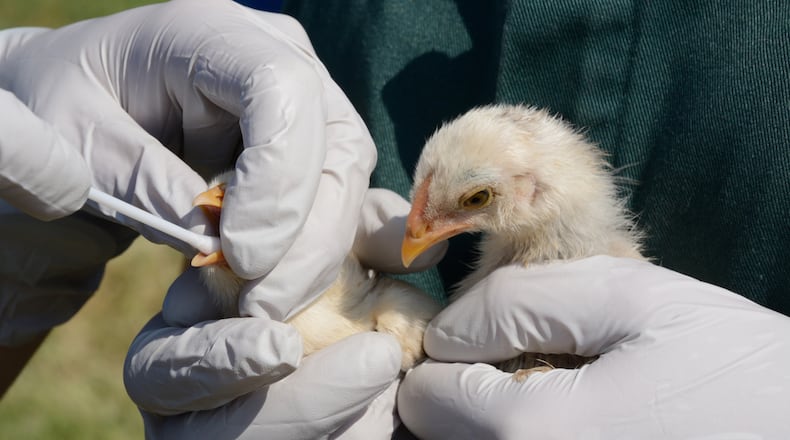A genetic analysis suggests the bird flu virus mutated inside a Louisiana patient in a way that could potentially make the virus more transmissible to humans, according to the Centers for Disease Control and Prevention.
The patient was reported last week to have the nation’s first severe case of the illness. Scientists believe the mutations could allow the virus to better bind to receptors in the upper airways of humans — something they say is concerning but not a cause for alarm.
The CDC noted this week there’s no evidence the virus was spread from the Louisiana patient to anyone else. The agency also stressed it’s not uncommon for viruses to change during the course of a single infection. Investigators say the situation would be more concerning if also found in samples from the bird, which would indicate the potential for wider spread.
“The changes observed were likely generated by replication of this virus in the patient with advanced disease rather than primarily transmitted at the time of infection,” the CDC said.
The patient was in contact with sick and dead birds in backyard flocks, the CDC said earlier this month. Agency officials didn’t immediately detail the patient’s symptoms, and no update has been provided on their condition.
One of the changes in the virus was similar to what was observed in the hospitalized patient in British Columbia, Canada, the agency said in its analysis.
Scott Hensley, a professor of microbiology at the University of Pennsylvania’s Perelman School of Medicine, cautioned against reading too much into data from two severe cases, though he admitted the CDC’s report was “enough to raise my eyebrows.”
“It’s not great news,” Hensley told online health news website STAT.
The CDC reported it compared viruses from the Louisiana patient to one from the infected poultry on the property. The mutations seen in the patient’s sample were not detected in the virus from the bird, which suggests the changes were taking place during the course of the person’s infection.
Hensley said it would have been more concerning if the mutations had been seen in the virus from the birds, because it would have suggested viruses in nature were acquiring these changes.
The Louisiana patient is the outbreak’s first human case in the Deep South. Bird flu has not yet been detected among humans in Georgia.
The Louisiana patient was infected with the D1.1 genotype of the virus that is closely related to other D1.1 viruses detected in wild birds and poultry and some recent human cases in the United States and the one in Canada. This is different from the B3.13 genotype detected in dairy cows and some human cases in multiple states.
Michael Osterholm, a University of Minnesota infectious disease researcher, likened this binding interaction to a lock and key. To enter a cell, the virus needs to have a key that turns the lock. “Right now, this is a key that sits in the lock, but it doesn’t open the door,” he said.
“Is this an indication that we may be closer to seeing a readily transmitted virus between people? No,” Osterholm told The Associated Press. “Right now, this is a key that sits in the lock, but it doesn’t open the door.”
Previous illnesses in the U.S. had been generally mild with symptoms of conjunctivitis. But in other countries, the bird flu virus, also known as H5N1, has been associated with severe illnesses leading to death in about 50% of cases. The vast majority of U.S. cases in humans have been among farmworkers exposed to sick poultry or dairy cows.
So far this year, there have been 65 human bird flu infections reported in 10 states, more than half of them in California. Also last week, California’s Gov. Gavin Newsom declared a state of emergency to improve the state’s response to bird flu after the virus was found in cows in Southern California.
Health officials say bird flu is still mainly an animal health issue, and the risk to the general public remains low. There’s been no documented spread of the virus from person to person.
There have been 120 cases of H5N1 confirmed in wild birds in Georgia since the current outbreak began in 2022, according to U.S. Department of Agriculture data.
The virus has also been detected in three backyard flocks in the state. The most recent incident came days before Thanksgiving in 2023, when the virus tore through a commercial duck farm in Sumter County, southeast of Columbus. Georgia agriculture officials responded to the case and ultimately culled more than 30,000 birds to contain the spread.
The Associated Press contributed to this article.
By the Numbers
The 2024 bird flu outbreak
901 confirmed cases in cattle in 16 states (Georgia is not one of them)
65 confirmed total human cases in the U.S.
39 exposed to dairy herds
23 exposed to poultry farms
2 human cases in California and Missouri acquired the virus from an unknown source
1 human case in Louisiana had an exposure to a backyard flock, wild birds or another mammal carrying the virus
Source: Centers for Disease Control and Prevention
About the Author
Keep Reading
The Latest
Featured




